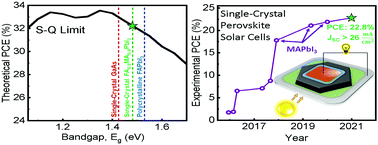22.8%-Efficient single-crystal mixed-cation inverted perovskite solar cells with a near-optimal bandgap†
Abstract
Expanding the near-infrared (NIR) response of perovskite materials to approach the ideal bandgap range (1.1–1.4 eV) for single-junction solar cells is an attractive step to unleash the full potential of perovskite solar cells (PSCs). However, polycrystalline formamidinium lead triiodide (FAPbI3)-based absorbers, used in record-efficiency PSCs, currently offer the smallest bandgap that can be achieved for lead-halide perovskite thin films (>100 meV larger than the optimal bandgap). Here, we uncover that utilizing a mixed-cation single-crystal absorber layer (FA0.6MA0.4PbI3) is capable of redshifting the external quantum efficiency (EQE) band edge past that of FAPbI3 polycrystalline solar cells by about 50 meV – only 60 meV larger than that of the top-performing photovoltaic material, GaAs – leading to EQE-verified short-circuit current densities exceeding 26 mA cm−2 without sacrificing the open-circuit voltage (VOC), and therefore, yielding power conversion efficiencies of up to 22.8%. These figures of merit not only set a new record for SC-PSCs and are among the highest reported for inverted-structured-PSCs, but also offer an avenue for lead halide PSCs to advance their performance toward their theoretical Shockley–Queisser Limit potential.

- This article is part of the themed collection: 2021 EES Lectureship winner: Sam Stranks


 Please wait while we load your content...
Please wait while we load your content...